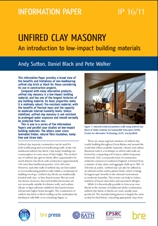Unfired clay masonry: An introduction to low-impact building materials
BRE (Building Research Establishment) is an independent, research-based consultancy, testing and training organisation, operating in the built environment and associated industries.
Unfired clay masonry: An introduction to low-impact building materials, was written by A Sutton, D Black and P Walker and published by BRE on 18 October 2011.
It is one of a series of five information papers and case studies about low-impact building materials, which also cover; hemp lime, straw bale, cross-laminated timber and natural fibre insulation.
In comparison with some alternative construction products, unfired clay masonry is relatively low-impact, and it has one of the longest histories of use of any building material. It is relatively robust, fire-resistant, has high thermal mass and has the capacity to moderate internal humidity levels. However, unless stabilised, it is not resistant to prolonged water exposure and so it normally requires protection from rain.
This 6-page information paper provides an overview of the pros and cons of non-loadbearing unfired clay brick and block. It is intended for those considering the use of this material on construction projects.
[edit] Related articles on Designing Buildings Wiki
- Adobe.
- Arup and Better Shelter at the Working Together For Disaster Relief conference.
- Blockwork.
- BRE articles on Designing Buildings Wiki.
- BRE Buzz articles on Designing Buildings Wiki.
- BRE Buzz.
- Brick.
- Building Research Establishment.
- Clay.
- Cob building.
- Cross-laminated timber.
- Defects in brickwork
- Defects in stonework.
- Earth building.
- Earthen construction.
- Green building.
- Hempcrete.
- Masonry.
- Parapet.
- Practical Building Conservation: Earth, Brick and Terracotta.
- Straw bale construction.
- Terracotta.
Featured articles and news
Restoring Great Yarmouth's Winter Gardens
Transforming one of the least sustainable constructions imaginable.
Construction Skills Mission Board launch sector drive
Newly formed government and industry collaboration set strategy for recruiting an additional 100,000 construction workers a year.
New Architects Code comes into effect in September 2025
ARB Architects Code of Conduct and Practice available with ongoing consultation regarding guidance.
Welsh Skills Body (Medr) launches ambitious plan
The new skills body brings together funding and regulation of tertiary education and research for the devolved nation.
Paul Gandy FCIOB announced as next CIOB President
Former Tilbury Douglas CEO takes helm.
UK Infrastructure: A 10 Year Strategy. In brief with reactions
With the National Infrastructure and Service Transformation Authority (NISTA).
Ebenezer Howard: inventor of the garden city. Book review.
The Grenfell Tower fire, eight years on
A time to pause and reflect as Dubai tower block fire reported just before anniversary.
Airtightness Topic Guide BSRIA TG 27/2025
Explaining the basics of airtightness, what it is, why it's important, when it's required and how it's carried out.
Construction contract awards hit lowest point of 2025
Plummeting for second consecutive month, intensifying concerns for housing and infrastructure goals.
Understanding Mental Health in the Built Environment 2025
Examining the state of mental health in construction, shedding light on levels of stress, anxiety and depression.
The benefits of engaging with insulation manufacturers
When considering ground floor constructions.
Lighting Industry endorses Blueprint for Electrification
The Lighting Industry Association fully supports the ECA Blueprint as a timely, urgent call to action.




















